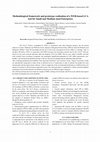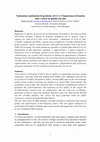Papers by Caterina Rinaldi

The "eLCA" Project, coordinated by ENEA in cooperation with other European partners, has the gene... more The "eLCA" Project, coordinated by ENEA in cooperation with other European partners, has the general objective to realise "Databases and WEB site for the adoption of Integrated Product Policy (IPP) by Small and Medium sized Enterprises (SMEs)". Since the knowledge and the use of Life Cycle Assessment (LCA) by SMEs is a strategic "step" to introduce IPP policy, ENEA, in cooperation with FEBE EcoLogic, has developed a specific tool for the "eLCA" Web-site, based on a five years research experience about the adoption of LCA by SMEs. The new tool, called "eVerdEE", provides solid scientific bases according to pragmatic and meaningful simplification/adaptation of ISO 14040 requirements; userfriendly, well structured and guided procedures with low time and cost demand and pre-elaborated data/meta-data. After compiling predefined and simplified "Goal and Scope Definition" and "Inventory" forms, "Impact Assessment" results are automatically interpreted in matrix forms at different levels of visualization in order to identify the product life cycle critical points and the improvement solutions. A direct comparison of the environmental performances of different life-cycle options of a product is allowed using a target-plot system. The whole procedure is supported by a matrix structured database containing environmental indicators of substances and processes for different impact categories. The software prototype has been tested on a sample of SMEs working in the Furniture and Wood sector and the main aspects for further development have been identified.

A key priority of European Union is how to support eco-innovation processes among enterprises, es... more A key priority of European Union is how to support eco-innovation processes among enterprises, especially small and medium-sized (SMEs) ones. Simplified tools like the LCA software eVerdEE, developed by ENEA, can help SMEs improve the environmental profile of their products and enter new markets (e.g. Green Public Procurement). The availability of up-to-date and consistent data is considered a fundamental element to guarantee the representativeness and robustness of LCA studies. In this regard, the LCA&Ecodesign research unit, in collaboration with the University of Modena, developed a utility to import the European Reference Life Cycle Data System (ELCD) into the eVerdEE database. The activity has been performed within the LISEA Laboratory, a project of Emilia Romagna Region. The new and revised eVerdEE database will make available to enterprises data of good quality and representative of the European context. This will support enterprises in performing LCA studies to identify impr...

Questo studio rappresenta un output richiesto dal Workpackage 3 del progetto PEFMED (Uptake of th... more Questo studio rappresenta un output richiesto dal Workpackage 3 del progetto PEFMED (Uptake of the Product Environmental Footprint across the MED agrofood regional productive systems to enhance innovation and market value), finanziato dal Programma Interreg Mediterranean 2014-2020, e finalizzato a ridurre l’impronta ambientale e di alcune filiere produttive agroalimentari titpiche della regione mediterranea, e ad implementare processi di ecoinnovazione lungo la catena produttiva. Il presente rapporto contiene l’analisi ambientale, effettuata per mezzo dell’applicazione della metodologia Europea di Product Environmental Footprint, della produzione di Taleggio DOP in una filiera situata in Lombardia, con l’obiettivo di identificare i punti critici ambientali del ciclo di vita del formaggio analizzato, di supportare l’identificazione di scenari di miglioramento e di testare l’applicabilita delle Product Environmental Footprint Category Rules (PEFCR).
Nell’ambito del progetto Presource, finanziato dal programma europeo Central Europe, e stato prod... more Nell’ambito del progetto Presource, finanziato dal programma europeo Central Europe, e stato prodotto questo report di progetto in cui e stata effettuata una breve ricognizione sull’analisi costi-benefici. L’obiettivo era quello di individuare le modalita piu efficaci per applicare tale metodologia all’approccio di valutazione delle prestazioni economico-ambientali da affiancare allo strumento EDIT VALUE Tool sviluppato dal progetto per l’analisi dell’efficienza nell’uso delle risorse nelle PMI.
Il documento presenta lo strumento EDIT Value (Eco-Innovation Diagnosis and Implementation Tool f... more Il documento presenta lo strumento EDIT Value (Eco-Innovation Diagnosis and Implementation Tool for Increase of Enterprise Value), che supporta le Piccole e Medie Imprese (PMI) nell’avvio di percorsi di eco-innovazione adatti alle caratteristiche della singola azienda e che generino risultati spendibili sul mercato. Lo strumento prevede quattro fasi: preparazione, identificazione dei potenziali di miglioramento, scelta delle applicazioni piu adatte per sfruttare i potenziali individuati e analisi costi-benefici delle possibili azioni, formulazione di un piano d’azione. In allegato sono forniti tutti i documenti disponibili a supporto delle varie fasi e una guida all’uso di EDIT Value.

Journal of Cleaner Production, 2017
Material and energy costs represent about 50% of the operating costs incurred by European small a... more Material and energy costs represent about 50% of the operating costs incurred by European small and medium-sized enterprises (SMEs). Although the potential for resource efficiency improvements is high, the necessary awareness and human resource capacities to explore this potential are limited. Existing tools for exploration of resource efficiency improvement potentials have several shortcomings: they are either tool-driven, of a solely qualitative nature or do not address all levels of a business. Users of such tools therefore miss important improvement opportunities. In order to overcome these limitations and to systematically identify, quantify and fully explore resource efficiency improvement potentials, an international team developed and tested a new comprehensive, needs-driven and quantitative diagnosis tool named the 'EDIT Value Tool.' This tool can be used to perform initial diagnoses for companies. The EDIT Value Tool was piloted in eighteen manufacturing SMEs in six Central European countries. Evaluation of the test results showed that the tool is effective in helping company personnel to identify the main weaknesses and the potentials for company improvements. The tool achieves this by evaluating a business's characteristics: its stakeholder values, the corporate strategy to implement its mission and vision, assessment of the effectivity of the company's management systems, processes and products. The benefits of using the EDIT Value Tool that were of most benefit to the companies were the proposed changes to corporate technology and management. The collection of quantitative and qualitative data helped company personnel to develop new perspectives on how to monitor and to improve resource efficiency and to increase awareness of and commitment to more sustainable manufacturing systems.
Ecosmes.net è un portale multilingue che intende supportare il processo di eco-innovazione delle ... more Ecosmes.net è un portale multilingue che intende supportare il processo di eco-innovazione delle piccole e medie imprese europee mettendo a disposizione informazioni, strumenti di formazione e software semplificati per l’analisi del ciclo di vita e l’eco-progettazione di prodotti

Integrated Environmental Assessment and Management, 2015
Automotive Shredder Residue (ASR) is a problematic waste material remaining after shredding and r... more Automotive Shredder Residue (ASR) is a problematic waste material remaining after shredding and recovery processes of end-of-life vehicles (ELVs). Its heterogeneous grain size and composition make difficult its recovery or disposal. Although ASR accounts for approximately 20% to 25% of the weight of an ELV, the European Union (EU)'s ELV Directive (2000/53/EC) requires that by 2015 a minimum 95% of the weight of an ELV must be reused or recovered, including a 10% weight energy recovery. The quantity of ASR is relevant: Approximately 2.4 million tons are generated in the EU each year and most of it is sent to landfills. This article describes a life cycle model of the "TEKNE-Fluff" process designed to make beneficial use of ASR that is based on the results of an experimental pilot plant for pyro-gasification, combustion, cogeneration, and emissions treatment of ASR. The goal of the research was the application of life cycle assessment (LCA) methodology to identify the environmental hot spots of the "TEKNE system" and use scenario analysis to check solutions to improve its environmental profile, supporting the design and industrialization process. The LCA was conducted based on data modeled from the experimental campaign. Moreover, different scenarios on shares of electricity and thermal energy produced by the cogeneration system and alternative treatment processes for the waste produced by the technology were compared. Despite the limitation of the research (results based on scaling up experimental data by modeling), impact assessment results are promising and sufficiently robust, as shown by Monte Carlo analysis. The TEKNE technology may become an interesting solution for the problem of ASR management: Besides representing an alternative to landfill disposal, the energy produced could avoid significant impacts on fossil resources depletion (a plant of 40 000 tons/y capacity could produce ∼147 000 GJ/yr, covering the annual need of ∼13 500 households). Integr Environ Assess Manag 2015;11:435-444. © 2015 SETAC.
Key Engineering Materials, 2002
TESPI (Tool for Environmental Sound Product Innovation) is the prototype of a software tool devel... more TESPI (Tool for Environmental Sound Product Innovation) is the prototype of a software tool developed within the framework of the "eLCA" project. The project, (www.elca.enea.it)financed by the European Commission, is realising "On line green tools and services for Small and Medium sized Enterprises (SMEs)". The implementation by SMEs of environmental product innovation (as fostered by the European Integrated Product Policy,
Clean Technologies and Environmental Policy, 2012
Small and medium-sized enterprises (SMEs) represent a key vector to introduce and diffuse eco-inn... more Small and medium-sized enterprises (SMEs) represent a key vector to introduce and diffuse eco-innovation in the market, because of their relevance to both the environment and the European gross domestic product. As they are often focused on continuous and incremental innovation of their products, the optimization of product eco-innovation paths can be considered a central aspect of their business. All

A key priority of European Union is how to support eco-innovation processes among enterprises, es... more A key priority of European Union is how to support eco-innovation processes among enterprises, especially small and medium-sized (SMEs) ones. Simplified tools like the LCA software eVerdEE, developed by ENEA, can help SMEs improve the environmental profile of their products and enter new markets (e.g. Green Public Procurement). The availability of up-to-date and consistent data is considered a fundamental element to guarantee the representativeness and robustness of LCA studies. In this regard, the LCA&Ecodesign research unit, in collaboration with the University of Modena, developed a utility to import the European Reference Life Cycle Data System (ELCD) into the eVerdEE database. The activity has been performed within the LISEA Laboratory, a project of Emilia Romagna Region. The new and revised eVerdEE database will make available to enterprises data of good quality and representative of the European context. This will support enterprises in performing LCA studies to identify impr...




Uploads
Papers by Caterina Rinaldi